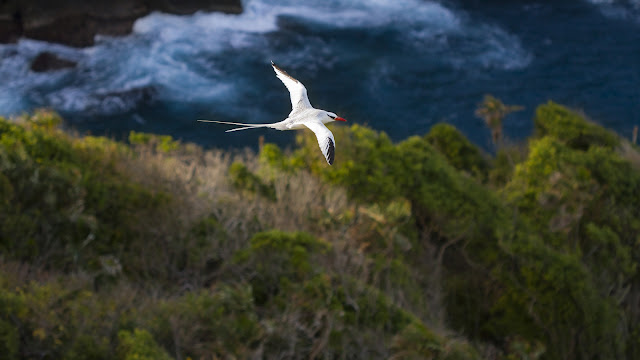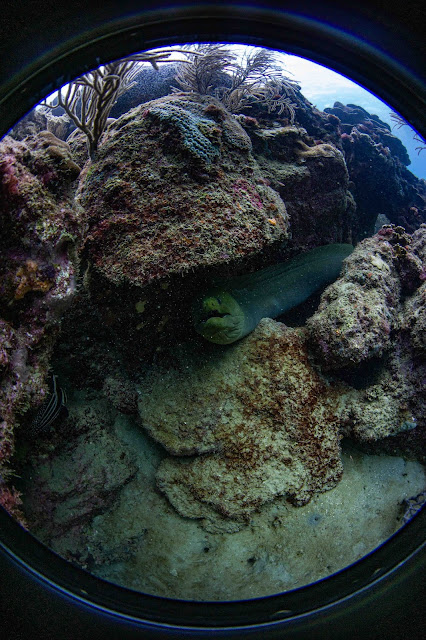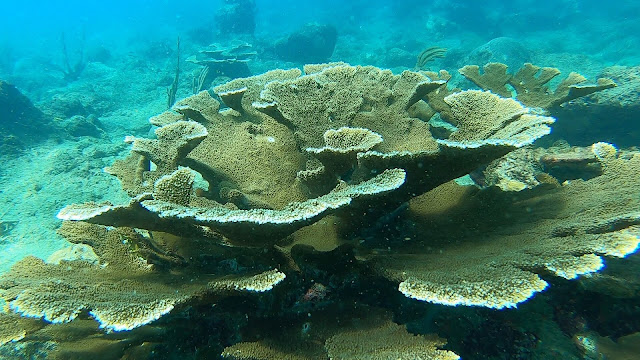What's a better name for a booby?
Faraaz Abdool looks into the seabird family that might most easily be seen on Little Tobago. All photos by Faraaz Abdool
The pool of bird names reveals all manner of information and inspiration. By themselves, birds are incredible creatures, emblematic of freedom and presence. Examining their names is an exploration of their lives in a unique and novel way – as we see them and allows us to refresh our perspective on our feathered friends.
Some bird names describe a physical characteristic. The Shoebill lurking in sub-Saharan swamps is a bird with a massive bill that recalls a Dutch clog. Others speak to a behavioral trait, if you see a bird pecking at wood, it’s likely a woodpecker. Names are sometimes onomatopoeic, such as “kiskadee” or “chachalaca” – as we know them, “cocrico”. Other times, they stir the imagination, for example “sungrebe” or “starthroat”. A few names pay homage to other languages; the desert cardinal of arid Northern Mexico is the Pyrrhuloxia – a combination of Greek terms.

Red-footed Boobies can be entirely
brown.

A Brown Booby bends its wings backward at an
extreme angle to protect itself as it enters the water at high speed.
Many birds were named by the people who first interacted with them. Early European sailors coined the term “booby” for several species of seabirds for their supposed stupidity. A derivative of the Spanish word “bobo” – which translates to “fool” or “stupid”, the name unfortunately stuck. Boobies are incredible birds, superbly adapted for their habits and habitat. They are extremely unlikely to be encountered on land. Not impossible, however, as birds have wings. A local birder once spotted a strange bird flying high above a landlocked village in southern Trinidad that was ultimately identified as a Masked Booby – not only a seabird, but an exceptionally rarely recorded one at that.
Boobies predominantly feed on fish and squid, with special emphasis on species that gather in great numbers. Their feeding method relies on keen eyesight – they need to first find their prey from hundreds of metres above the surface of the water, then pinpoint a target. Transmogrifying into a missile the bird then plummets into the ocean, sometimes entering at speeds exceeding 100 km/h. If their intended target eludes this initial entry, powerful, webbed feet can propel some members of this family to depths of 25m in pursuit of their prey. Wings that soar into the clouds become afterburners as they seek to grab animals that spend their entire lives underwater.
Surely, boobies could not be “regular birds”. Birds fly, and that is remarkable on its own. To be expertly adapted to life in the air and in the water is the combination of skillsets that are worlds apart. We are familiar with pelicans, who plunge into the water with open beaks and expandable pouches. We know anhingas and cormorants, submarine prowlers that sneak up on unsuspecting fish and unleash a spring-loaded dagger of a bill that impales upon impact. To successfully exploit the very sophisticated ecological niche of the booby family, birds boast specific morphological characteristics that enable this high-octane, high-risk lifestyle.
 |
| Magnificent Frigatebirds mob a Red-footed Booby,
provoking it until it regurgitates its fishy meal. |
Hitting the water at such blinding speed is dangerous business. Upon impact, each eye is covered by a translucent third eyelid called the nictitating membrane. Boobies do not have external nostrils, as absolutely no-one enjoys having water flow into their nose. Especially lithe shoulder joints ensure that wings can be bent as far back as possible, lying flat along the bird’s back as it crosses the threshold between air and water. All four toes are webbed, ensuring maximum propulsion underwater. A long bill with serrated insides helps to prevent struggling fish from slipping away; only hefty fish are impaled.
This extreme means of capturing food ensures that conditions must be right, within reason of course. Relying on the ocean for food is working with a fickle beast, after all. At the very least, waters must have enough visibility for the roaming seabirds to spot a feeding opportunity. This is the primary reason why boobies aren’t commonly seen around much of Trinidad’s coasts, as the island sits in such close proximity to continental river outflow. Around Tobago, however, boobies are a more familiar sight. While boobies often feed out of sight of land, they tend to remain relatively near to the continental shelf. The islands off the coast of northeastern Tobago are therefore a hotbed of activity for T&T’s species of boobies.
These rocky islands are the nesting grounds for hundreds of Red-footed and Brown Boobies. Both species build nests out of dry leaves and twigs, but they differ in their preferred locations: Red-footed Boobies opt for the more traditional nest set in a fork in a tree, while Brown Boobies build nests on the ground. This decision may seem to justify the origin of the name, but boobies traditionally nest on uninhabited, inaccessible offshore islands free of terrestrial predators. As lethal as they are in the air and water, on land boobies are clumsy creatures and thus rely heavily on their breeding grounds remaining free of any marauding mammals such as rats or cats.

A white morph Red-footed Booby sits on a snag, a
short distance away from a well-camouflaged white-tailed Red-footed Booby that
is sitting on a nest. 
Sometimes injuries occur. This Brown Booby
nurses an injured wing.
As their name implies, Red-footed Boobies have red feet, and Brown Boobies are mostly chocolate brown. Interestingly, Red-footed Boobies occur in a few different colour morphs or variations – there is most confusingly an entirely brown morph Red-footed Booby that is overall much browner than a legitimate Brown Booby that is brown above and white below. Also occurring within the Red-footed Booby population on the islands off Tobago is an almost entirely white morph, as well as an intermediate morph that boasts a brown body and white tail. Colour variations do not necessarily imply any degree of segregation, as Red-footed Booby colonies typically consist of more than one colour morph. There is no geographic separator either, across their wide range Red-footed Boobies occur in a myriad of intergrades between fully brown and fully white. Their namesake red feet are consistent throughout!
Despite the unfortunate origin of their name, boobies and their larger cousins – gannets – remain an unparalleled family throughout their global range. Charismatic and extremely distinctive, we should keep an eye out for their sleek silhouette as we share T&T’s coastal waters with these amazing creatures.




